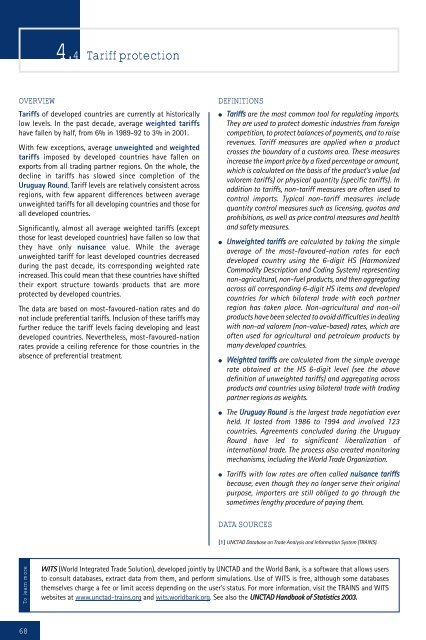Development and Globalization: - Unctad
Development and Globalization: - Unctad
Development and Globalization: - Unctad
Create successful ePaper yourself
Turn your PDF publications into a flip-book with our unique Google optimized e-Paper software.
OVERVIEW DEFINITIONS<br />
Tariffs of developed countries are currently at historically<br />
low levels. In the past decade, average weighted tariffs<br />
have fallen by half, from 6% in 1989-92 to 3% in 2001.<br />
With few exceptions, average unweighted <strong>and</strong> weighted<br />
tariffs imposed by developed countries have fallen on<br />
exports from all trading partner regions. On the whole, the<br />
decline in tariffs has slowed since completion of the<br />
Uruguay Round. Tariff levels are relatively consistent across<br />
regions, with few apparent differences between average<br />
unweighted tariffs for all developing countries <strong>and</strong> those for<br />
all developed countries.<br />
Significantly, almost all average weighted tariffs (except<br />
those for least developed countries) have fallen so low that<br />
they have only nuisance value. While the average<br />
unweighted tariff for least developed countries decreased<br />
during the past decade, its corresponding weighted rate<br />
increased. This could mean that these countries have shifted<br />
their export structure towards products that are more<br />
protected by developed countries.<br />
The data are based on most-favoured-nation rates <strong>and</strong> do<br />
not include preferential tariffs. Inclusion of these tariffs may<br />
further reduce the tariff levels facing developing <strong>and</strong> least<br />
developed countries. Nevertheless, most-favoured-nation<br />
rates provide a ceiling reference for those countries in the<br />
absence of preferential treatment.<br />
To learn more<br />
68<br />
4.4 Tariff protection<br />
● Tariffs are the most common tool for regulating imports.<br />
They are used to protect domestic industries from foreign<br />
competition, to protect balances of payments, <strong>and</strong> to raise<br />
revenues. Tariff measures are applied when a product<br />
crosses the boundary of a customs area. These measures<br />
increase the import price by a fixed percentage or amount,<br />
which is calculated on the basis of the product's value (ad<br />
valorem tariffs) or physical quantity (specific tariffs). In<br />
addition to tariffs, non-tariff measures are often used to<br />
control imports. Typical non-tariff measures include<br />
quantity control measures such as licensing, quotas <strong>and</strong><br />
prohibitions, as well as price control measures <strong>and</strong> health<br />
<strong>and</strong> safety measures.<br />
● Unweighted tariffs are calculated by taking the simple<br />
average of the most-favoured-nation rates for each<br />
developed country using the 6-digit HS (Harmonized<br />
Commodity Description <strong>and</strong> Coding System) representing<br />
non-agricultural, non-fuel products, <strong>and</strong> then aggregating<br />
across all corresponding 6-digit HS items <strong>and</strong> developed<br />
countries for which bilateral trade with each partner<br />
region has taken place. Non-agricultural <strong>and</strong> non-oil<br />
products have been selected to avoid difficulties in dealing<br />
with non-ad valorem (non-value-based) rates, which are<br />
often used for agricultural <strong>and</strong> petroleum products by<br />
many developed countries.<br />
● Weighted tariffs are calculated from the simple average<br />
rate obtained at the HS 6-digit level (see the above<br />
definition of unweighted tariffs) <strong>and</strong> aggregating across<br />
products <strong>and</strong> countries using bilateral trade with trading<br />
partner regions as weights.<br />
● The Uruguay Round is the largest trade negotiation ever<br />
held. It lasted from 1986 to 1994 <strong>and</strong> involved 123<br />
countries. Agreements concluded during the Uruguay<br />
Round have led to significant liberalization of<br />
international trade. The process also created monitoring<br />
mechanisms, including the World Trade Organization.<br />
● Tariffs with low rates are often called nuisance tariffs<br />
because, even though they no longer serve their original<br />
purpose, importers are still obliged to go through the<br />
sometimes lengthy procedure of paying them.<br />
DATA SOURCES<br />
[1] UNCTAD Database on Trade Analysis <strong>and</strong> Information System (TRAINS).<br />
WITS (World Integrated Trade Solution), developed jointly by UNCTAD <strong>and</strong> the World Bank, is a software that allows users<br />
to consult databases, extract data from them, <strong>and</strong> perform simulations. Use of WITS is free, although some databases<br />
themselves charge a fee or limit access depending on the user's status. For more information, visit the TRAINS <strong>and</strong> WITS<br />
websites at www.unctad-trains.org <strong>and</strong> wits.worldbank.org. See also the UNCTAD H<strong>and</strong>book of Statistics 2003.

















